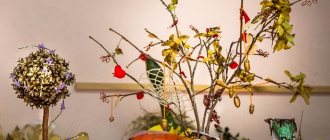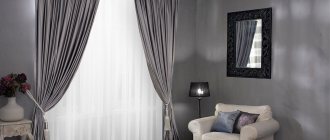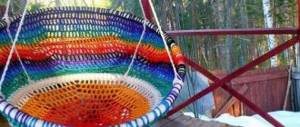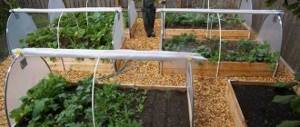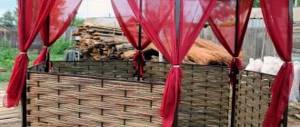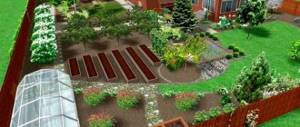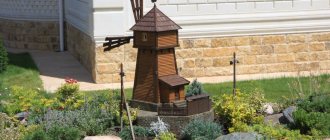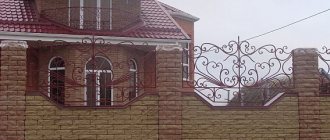Advantages and disadvantages
Bulk flower beds have gained wide popularity among owners of private houses due to a large number of advantages:
- Possibility of constructing various and unique forms of construction. To obtain an exclusive design composition, you should combine geometric shapes with several types of filler.
- Long service life and increased structural strength. If you install flower beds correctly, the fence will last much longer than other products that were made from other materials.
- Protective functions of the structure. Tall bulk products can reliably hide the territory of a fenced area from passers-by. In addition, the fenced area can provide protection from strong gusty winds.
- Possibility of installation on any site.
- The high level of plasticity of the product allows you not to worry about minor soil displacements. The fence is not subject to deformation.
- Possibility to decorate the structure. A flowerbed made from construction mesh with your own hands can be an excellent basis for vertical gardening.
The disadvantages of gabions are the bulkiness of the structure, as well as the significant financial investments that will be required if non-standard filler is used.
It is better not to build bulky structures in a small yard
How to make a gabion yourself
There are many companies on the modern market for which the production of gabion structures is one of their main areas of activity. From such companies you can order a turnkey fence made of gabions or a structure made of mesh and stones for any other purpose.
To save on such services, you can make gabions with your own hands, strictly following the recommendations of specialists.
So, in order to make your own gabion, you need to develop a project for the future structure, taking as a basis, for example, a photo from the Internet. To develop a project you need to perform the following steps:
- take measurements of the area where the future structure is planned to be installed;
- mark the installation location of the gabion;
- draw up a drawing of the future structure indicating all its dimensions;
- select gabion filling material;
- calculate the amount of materials from which the structure will be made.
It should be kept in mind: in order to ensure that you definitely have enough materials, their quantity, which will be obtained as a result of the calculations made, must be multiplied by 10–15% (and purchased with such a reserve). When choosing a mesh for your future gabion, pay attention to products with double torsion. This mesh is more flexible, but also has higher strength and reliability.
Which stone to choose
The metal frame is filled with neat layers or in a chaotic manner with filler. If desired, you can use stones of different fractions and color shades. This will make it possible to create an original flowerbed with images or textured compositions.
Natural
Natural stones are characterized by a high level of strength and durability. Such advantages cannot but rejoice, because the stone will be exposed to natural influences, so its reliability cannot be doubted. When choosing a natural filler, you can give preference to:
- Sandstone is a clastic sedimentary rock. It is better to make small flower beds from sandstone
- Granite is an igneous plutonic rock. Granite looks quite attractive and will allow you to create unusual flower garden patterns
- Quartz is a common igneous rock mineral. Quartz will add special sophistication to stone flower beds
- Pebbles - rock fragments rounded to varying degrees. Pebbles are considered the most common and affordable material for stone flower beds
- Diorite is an igneous plutonic rock. The use of diorite in the construction of a flower bed will add zest to the landscape design of the site
- Basalt is an igneous volcanic rock. Basalt is often used in combination with granite
- Flagstone - plates of natural stone. Flagstone is used not only in the process of constructing flower beds, but also to create fences
Artificial
Artificial stones can be purchased at a more reasonable price, which is considered a significant advantage. This type of filler is characterized by matching geometric parameters. When choosing a stone, it is worth considering that the diameter of the filler should be larger than the size of the mesh cells.
The use of shining stones as a filler allows you to create an unusual design
What are gabions and their design features
The military knows firsthand what a gabion is. It was from this area that engineers borrowed the idea of using them.
Gabion structures are a box made of a double mesh of 2-6 mm, depending on the height and filling. All kinds of materials can be located inside. The most commonly used are crushed stone and stone of various sizes, as well as pebbles and wood. But it all depends on the owner’s imagination and his financial capabilities, combined with the overall stylistic decision for the site.
Main types of gabion structures
There are several types of boxes for these products:
- Flat . The purpose is to strengthen the slopes and banks of reservoirs.
- Box gabions . The shape resembles a rectangle or square.
- Cylinders . Act as supports. This kind of gabion fence is easier and cheaper to build with your own hands than a classic one made of brick or other building material. It is acceptable to use this form for garden furniture.
- Arbitrary designs. They assume that the owner has taste and indispensable experience in working with simple variations of products.
What types of meshes are used in structures
To create gabion structures, different types of mesh are used. It’s easy to build a gabion from a chain-link mesh, but this design is no different in strength and durability. Galvanized or PVC-coated wire eliminates corrosion and is highly aesthetic. Gabion mesh also differs in the type of cells. Typically hexagonal or rectangular shapes are used. You can fasten sides or even several products into a single structure either with brackets and clamps for the frame, or by welding.
Welded mesh structures will last for many years
Welded mesh gabions, like small rectangular or square ones, can be purchased in stores. But if desired, they are also easy to design yourself.
What tools are needed to create a gabion with your own hands?
To work on the product, in addition to the mesh and filler, you will need the following materials:
- galvanized fasteners or welding machine;
- substrate (sand, geotextile, thick black film);
- reinforcement for rigidity (only in the case of volumetric figures);
- meter, shovel, pliers, thick gloves;
- anti-corrosion coating (applied after welding).
Different materials can serve as filler, but preference is given to stones of different fractions.
The entire process consists of preparing the base, installing the frame and filling it. When constructing large objects, so that the structure does not deform under the weight of the filler, you should take care of the stiffeners and install corner reinforcement. It would be a good idea to secure the parallel walls with thick wire braces. But all gabions are installed manually without much effort and complex technical means.
When using multi-fraction filling material, galvanized welded mesh for gabions can be supplemented with a chain-link that prevents the spilling of small stones or crushed stone with pebbles.
Tools for making flower beds
Before you begin, you need to prepare tools and materials:
- Durable galvanized mesh. To make a small flower bed, the thickness of the wire can be within 2-3 mm. When creating larger structures, it is better to purchase a mesh whose wire thickness reaches 6 mm. You should not use a chain-link mesh that cannot withstand heavy loads.
- Wire staples (galvanized) to help secure the frame.
- Sand.
- Thick black film that will be needed for the backing.
- A large number of stones, pebbles and broken bricks for filler.
- Reinforcement that gives rigidity to the structure.
Advice! During the work you will need a shovel, pliers and a tape measure. The mesh for gabions must be strong
Fastening gabions together
Knitting wire is used both to connect the walls of the box and to fasten adjacent boxes to each other. It is particularly durable, quite flexible in structure and resistant to external weather conditions.
In addition, some craftsmen in practice use galvanized staples, which help connect the boxes vertically.
How to make a flowerbed from a metal mesh with stones
In order to build a flowerbed from gabions, you first need to prepare the site. The place for the flower bed must be cleared of weeds and debris. The top layer of soil is removed. To achieve maximum stability of the flowerbed, you will need to make a recess within 10-12 cm. The base is leveled, after which a layer of sand or small crushed stone is added, over which a thick black film is stretched. The manufacturing of the structure occurs in stages:
- The mesh is cut into pieces. The frame part is assembled with your own hands. It is worth strengthening the structure with bricks for a while. The sides of the frame part are fixed with staple pliers.
- To make it easy to assemble a flowerbed, you can use a stretched spring screwed into the cells of the walls located nearby.
The wire is fixed at the ends with pliers. In order to increase the stability of the gabion, bricks can be laid on the surface of the bottom of the product. The fixed gabion will be strong enough . Important! At the base the mesh is fixed with anchors. - The frame part is filled with stones. The filler is placed quite tightly, which will make it possible to avoid loss of the shape of the structure. Larger stones should be placed in the outer parts of the grid. It is recommended to lay the filler in layers, not forgetting to compact each layer. The inner wall is covered with geotextiles, and the flower bed is filled with a layer of soil.
- The upper part of the structure is covered with a net. You can leave it open if you wish. Perennials are planted in the flower garden.
Below is a photo of the resulting flowerbed made of metal mesh with stones:
You can plant lavender and mint in a gabion
Gabion flowerbed in the shape of a cylinder
Before you start creating such an exquisite design, you should decide on the diameter of the flower bed. After this, you can cut the mesh according to the selected dimensions. MK flowerbeds made of mesh and stones:
- The mesh is rolled into a cylinder shape, overlapping a couple of cells. The structure can be secured with staples; the protruding rods of the cells are bent inward with pliers. Spandbond is cut into strips, the size of which coincides with the dimensional characteristics of the mesh. The metal product is wrapped and secured with staples. It is very important to lay the spandbond correctly, with the matte porous side facing out. In this case, moisture will evaporate slowly.
- The outer side is wrapped in black thick film. Gabion cylinders are installed in a pre-prepared area, which is covered with a layer of spandbond. A second mold is constructed in a similar way, the diameter of which is much smaller than the previous one. Both cylinders are connected using staples. The product is filled with filler. A layer of fertile soil is poured into the inner gabion. Now you can start planting perennials. It is recommended to add a layer of crushed stone around the cylindrical flower bed.
Gabion flowerbed in the shape of a spiral
Step-by-step production of a gabion flower bed with a spiral will allow you to create a chic design with your own hands, which will become a real decoration of the site:
The recommended height of the frame part is 100 cm, the width of the flower bed is 1 m. The width for filling with stones should be within 10 cm. Using metal scissors, you should cut a cascade from the mesh. Thus, a pair of identical parts is prepared, which will become the inner and outer sides of the gabion. It will be necessary to drive reinforcement into the central part of the product and into the bend area in order to increase the rigidity of the frame. The internal and external parts are fixed to the reinforcement using brackets. The joint area is secured with staples. It is advisable to fix hooks between the meshes to prevent the frame from bursting with stones.
The area between the grids can be filled with stones, which should be placed tightly in layers. Free zones can be filled with soil mixture, after which flowers can be planted in the flower beds.
Making flower beds from mesh and stones is quite simple if you strictly follow the instructions. If desired, you can use artificial decorative filler.
A spiral gabion will effectively decorate the area in the yard
How did the gabion appear?
Such designs were first used to protect artillery and gun batteries during the Napoleonic and Crimean War campaigns. Wicker baskets were tightly packed with earth and sand, which made it possible to hide from enemy fire and shrapnel. The military does not forget about gabions today - fortifications are now erected using bulldozers.
The “peaceful” purpose of gabions is to strengthen the banks and river beds, slopes during road construction and during the construction of buildings. And recently, gabions have become actively used in landscape design.
Flowerbed care
Caring for flower beds made of stones and mesh is quite simple. Most importantly, in a timely manner:
- moisten the soil;
- destroy weeds;
- remove plants that have bloomed;
- add fertilizer to the soil.
During particularly dry periods, it is important to water the rock beds daily. To reduce the time spent on caring for the structure, you should mulch the soil in the flowerbed; you can reduce the time spent on maintenance. In this case, weeds will not grow, the soil will remain loose, and the plants can be watered less frequently.



